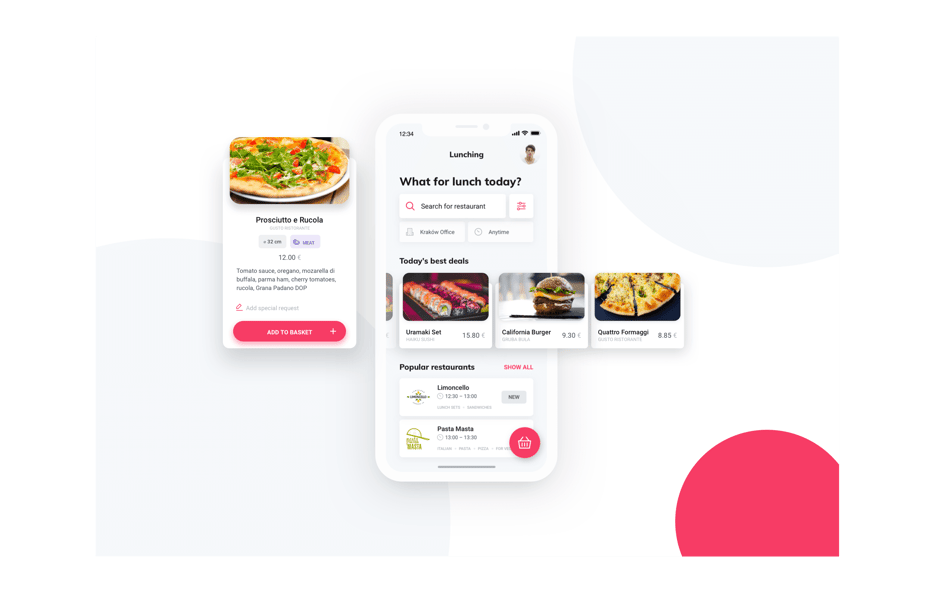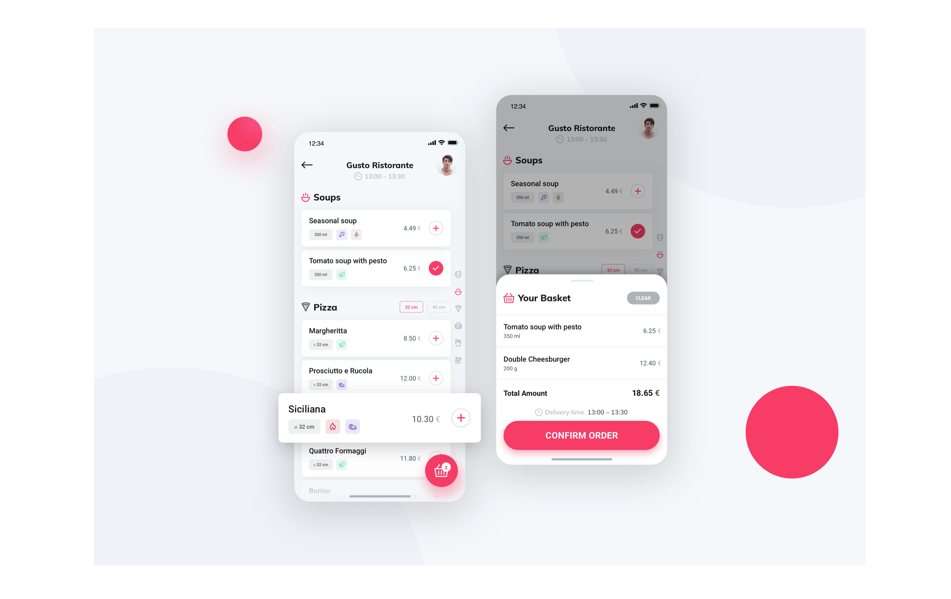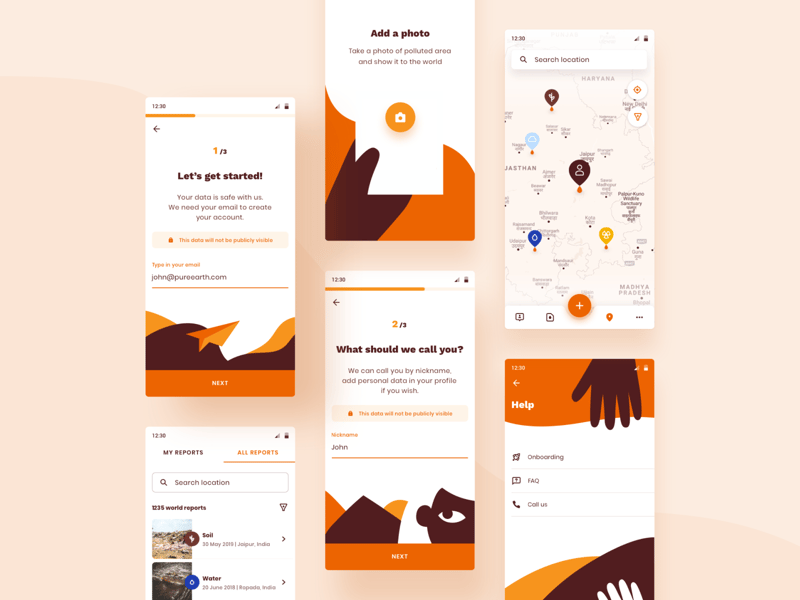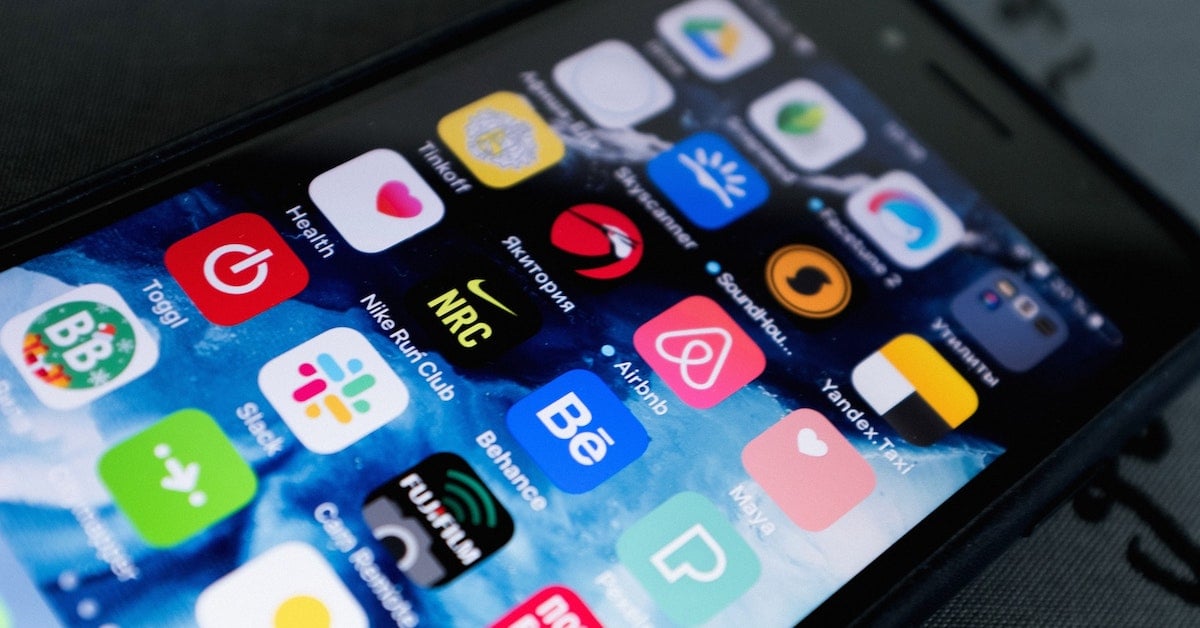

Build and deploy apps for iOS and Android with Flutter application development
Get your app onto the market fast using a single codebase
Cross-platform mobile app development made easy
Achieve your business goals with Flutter application development
-
Expand your reach. 1.8 billion people worldwide purchase goods online. Sell more with convenience, ease, and speed
-
Increase brand exposure. Apps account for over 90% of the time spent online time using smartphones. Be where your customers are
-
Build engagement and loyalty. Send out relevant marketing messages at the right time and use push notifications to increase retention
-
Optimize your tactics. Collect and use data to create an exceptional user experience and increase the effectiveness of your efforts
Lunching – a food delivery app developed for iOS and Android
Uber Eats, DoorDash, Delivery Hero, and Lunching.pl – these food delivery apps are changing the way we order our takeaway food.
We decided to build a cross-platform app based on the Flutter framework as an internal project. Food ordering and delivery apps are perfect for Flutter because of the low level of complexity – yet they need to have a beautiful design to present tasty food photos and a quick and user-friendly ordering flow.

-
Flutter is a very promising cross-platform technology. I was surprised how easily the team could begin working on Flutter applications and how quickly the first results were delivered.

Radosław Szeja
Mobile Engineering Manager at Netguru
Design an app that attracts and retains user attention
-
Fast development. Flutter gives you a universal set of UI building blocks and clear layered architecture. Experiment freely, add features, and remove bugs in no time.
-
Flexible UI. Flutter’s widgets are adaptable and make your UI flexible, so you can reuse the modules and whole sets of components in different layout configurations.
-
Cross-platform. Create mobile apps that can run across multiple device platforms using Flutter – it offers rapid development to help you get your app to market faster.
-
Hot Reload. With the hot reload function in Flutter, you can see every change you make immediately in the app. Code faster, more easily, and with greater accuracy.
Get native performance with a single cross-platform code base
Flutter is open source software – the SDK uses a C++ rendering engine and is based on the Dart programming language. It also provides widgets out of the box, and its architecture is based on reactive programming, which means that web and mobile apps built with Flutter are extremely responsive and provide the user with high performance.
-
Audience. Define the users of your Flutter mobile or web app
-
Business model. Develop your strategy and identify potential revenue streams
-
Scope. Identify your app’s core features and critical functionality
-
Development. Select the experts to bring your Flutter app to life
-
Marketing strategy. Choose the right marketing approach and tools
-
Regular updates. Fix bugs and continuously improve your app
What is Flutter?
Contents
Flutter is an open-source SDK developed by Google that enables developers to create high-quality, cross-platform applications with a single codebase. Unlike traditional libraries or frameworks, Flutter is a complete UI software development kit, providing everything you need to build stunning apps for:
-
Android
-
iOS
-
Desktop
-
Web
Flutter’s secret sauce lies in its ability to support non-standard web apps with complex UI/UX, while offering a vast library of UI components (Widgets) that help save on development costs and achieve a fast development cycle, all thanks to the Flutter framework.
The versatility of Flutter is showcased in its ability to run on multiple operating systems, including Android, iOS, Windows, macOS, Linux, and web applications, providing a consistent user interface across platforms. The Flutter team continuously works to improve its features and performance, as seen in the recent release of Flutter 3, which now supports macOS and Linux desktop apps, Firebase integration, native development support for Apple Silicon, and many productivity and performance enhancements.
Notably, Flutter’s hot reload feature impresses many, as it enables developers to:
-
Visualize changes in real-time without restarting the app
-
Speed up the development process
-
Make it easier to experiment with different layouts and designs.
How does Flutter work?
At its core, Flutter uses the Dart programming language, its own rendering engine, and a vast collection of customizable widgets. This powerful combination allows for rapid development, smooth animations, and a consistent look and feel across all platforms.
Flutter widgets are the building blocks of the user interface and are inspired by React. They offer a huge selection of pre-made, customizable UI components, including stateful widgets, which can be combined to create unique and visually appealing layouts. The Dart programming language plays a crucial role in Flutter, as it supports both strong and weak typing styles, making it accessible to newcomers. Additionally, Dart handles both layout and code in one place, as everything in Flutter is a widget, eliminating the need for mediators and making Flutter faster and more efficient than its competitors like React Native.
Some of the cool native device features Flutter offers include access to the camera and geolocation, as well as support for over 30 packages for state management. Furthermore, the hot reload feature enables instantaneous visualization of code changes in an emulator, eliminating the need for app recompilation and relaunch. This makes Flutter an attractive option for developers looking to create high-performance apps with real-time updates and notifications.
Why should you consider Flutter for app development?
Multiple factors make Flutter a compelling choice for app development, including its support for cross platform development. One of the most significant advantages is the ability to use a single codebase for multiple platforms. This means you can create Android, iOS, desktop, and web versions of your app using the same code, saving time and resources. Additionally, Flutter’s native-level performance ensures that your app runs smoothly and efficiently on all platforms, providing a seamless user experience.
Additionally, Flutter’s ability to facilitate faster development cycles is another attractive feature. With its vast library of ready-made widgets and the hot reload feature, developers can quickly prototype, test, and iterate on their app designs, speeding up the development process and reducing costs. Furthermore, the growing ecosystem of libraries and tools available for Flutter makes it easier for developers to enhance their app’s features and boost productivity.
From an enterprise app development perspective, Flutter offers the following benefits:
-
Scalability and robustness, attributed to its hot reload feature and compatibility with large codebases
-
Handy code and UI debugging tools that work on both platforms, ensuring a smooth development process
-
High-quality final product
How do Flutter widgets help in mobile app development
Flutter widgets significantly contribute to mobile app development, offering an extensive assortment of customizable UI components for creating unique and visually captivating layouts. This streamlines the Flutter app development process and ensures a consistent user experience across platforms, making Flutter app development services highly sought after.
Some of the popular widget categories in Flutter include Material Design widgets and Cupertino widgets, which help create a consistent user interface across platforms. These widgets, along with the hot reload feature, contribute to a fast development cycle, allowing developers to quickly prototype, test, and iterate on their app designs.
Nevertheless, employing Flutter widgets for UI coding can pose challenges, especially for large applications that may necessitate up to 10 code layers to create a basic object. As a result, developers need to plan their app structure carefully and consider how to best utilize Flutter widgets when building apps to create visually appealing and efficient layouts.
Easy to learn
When using a new SDK in a project, you should always take a closer look at how many people are using it and how steep the learning curve is. In the case of Flutter, both are very promising. While the main challenge is knowledge of Dart (frameworks like React Native use the more popular JavaScript), even beginner developers can build quick prototypes and apps with Flutter.
Thanks to Google's support and developers contributing to the open source project, Flutter is growing rapidly. This means that there is an increasing number of Flutter developers, making it more accessible to businesses.
Superb documentation
Flutter is easy to learn – while the main challenge is getting to know Dart (React Native uses the more popular JavaScript), even beginner developers can build fast prototypes and apps with Flutter. Thanks to the work of the open source community, and under Google's supervision, Flutter is growing very fast.
Flutter has clear and well-written documentation, and there are valuable tutorials available online, plus it has a growing community of developers around the world who are happy to provide support. This means that there are more and more young developers using Flutter, making it more accessible to businesses.
Hot reload for faster design
Flutter features hot reload, a valuable function that boosts the productivity of developers. Hot reload lets developers see their changes in real time, allowing them to code faster and with greater accuracy.
Hire a high-performing, talented team that brings great ideas to life
At Netguru, we have more than 650 specialists (UI/UX designers, full-stack developers, quality assurance, business analysts) creating custom mobile app solutions for the iOS and Android mobile platforms. Work with the team that combines proven technical ability and excellent business skills to bring your Flutter app to life.
Introducing the Lunching app – a Flutter food delivery platform
Lunching is a concept app for a corporate food delivery system where employees can order lunch from nearby restaurants to their office. Thanks to the Lunching app you can see the nearest restaurants, check the best deals, and see the full menu prepared for today.
We’ve designed a simple 4-click ordering flow to not waste your time on choosing today’s meal. All the amazing food photos are spiced up with beautiful animations.

Global environment protection with the Report Pollution app
We decided to introduce R&D for Good, a program leveraging our smart innovation expertise to support non-governmental organizations in their digital journeys.
Our first partner became Pure Earth, a New York-based international non-profit organization acting to clean up toxic pollution around the world.
The main functionality of the Report Pollution app is documenting and reporting polluted sites that users have direct contact with. They can take and annotate pictures, describe the pollution and what impact it has on the environment and people around it, and then send that report to Pure Earth via the app AND anyone else via social media.

Our partners on working with Netguru
-
"I've really appreciated the flexibility and breadth of experience we've been able to tap into from the Netguru team. While most of our work together has been in React Native, at times when needed, we've also gotten support in QA, design, UX, iOS and Android as well."

Jonathan Uy
CTO at Shine -
"About three years ago we decided that we wanted to be a technology-independent company. Netguru has been the best agency we've worked with so far. The team is able to design new skills, features, and interactions within our model, with a great focus on speed to market."

Adi Pavlovic
Director of Innovation at KW -
"Working with the Netguru Team was an amazing experience. They have been very responsive and flexible. We definitely increased the pace of development. We’re now releasing many more features than we used to before we started the co-operation with Netguru."
.jpg?width=65&height=65&name=Marco%20Deseri%20Artemest-s(1).jpg)
Marco Deseri
Chief Digital Officer at Artemest
15+
Years on the Market400+
People on Board2500+
Projects Delivered73
Our Current NPS Score
Delivered by Netguru
We are actively boosting our international footprint across various industries such as banking, healthcare, real estate, e-commerce, travel, and more. We deliver products to such brands as solarisBank, PAYBACK, DAMAC, Volkswagen, Babbel, Santander, Keller Williams, and Hive.
$5M
Granted in funding. Self-care mobile app that lets users practice gratitude$28M
Granted in funding. Investment platform that enables investment in private equity funds$20M
Granted in funding. Data-driven SME lending platform provider$47M
Granted in funding. Lead generation tool that helps travelers to make bookings
What is Flutter, and how can it benefit my project?
Read more on our blog
Find answers to some of the most important questions on developing an app using Flutter:
Our work was featured on
Curious whether Netguru is the right fit for your project?
Schedule a free expert session with a Mobile Engineering Manager
Get growth tips, that will make your business sky-rocket.

Radosław Szeja
Radek is a manager of the Mobile Department at Netguru. He's strongly focused on business growth and team management.


